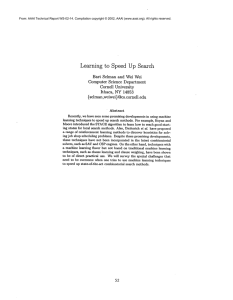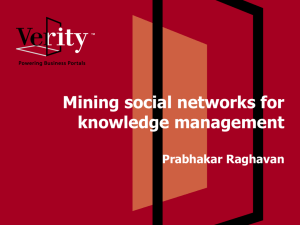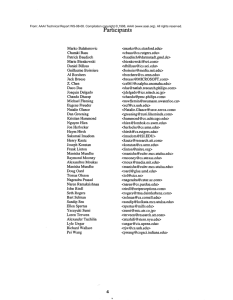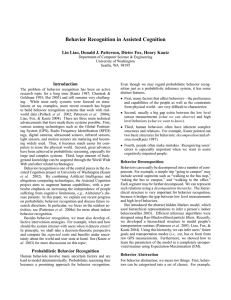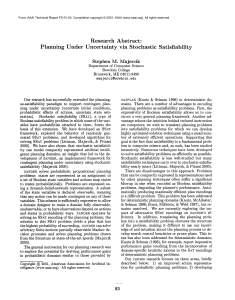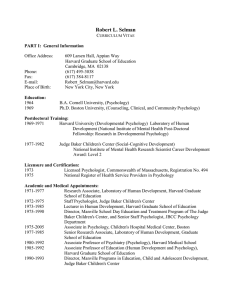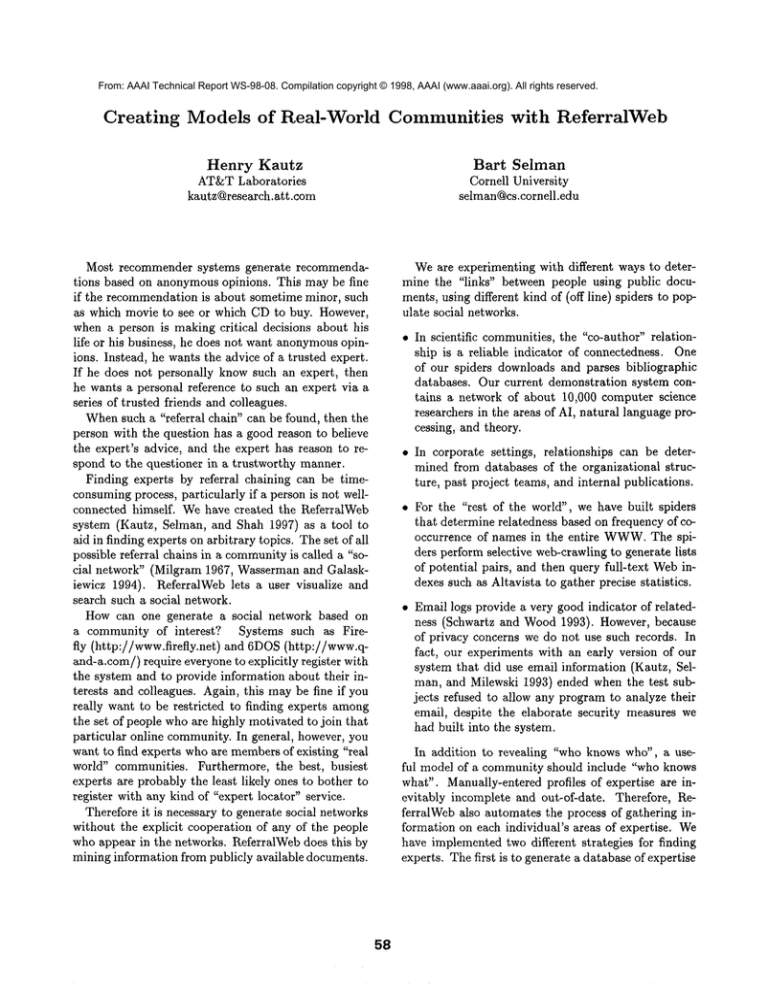
From: AAAI Technical Report WS-98-08. Compilation copyright © 1998, AAAI (www.aaai.org). All rights reserved.
Creating
Models of Real-World
Communities with ReferralWeb
Bart gelman
Cornell University
selman@cs.cornell.edu
Henry
Kautz
AT&TLaboratories
kautz@research.att.com
Most recommender systems generate recommendations based on anonymousopinions. This may be fine
if the recommendation is about sometime minor, such
as which movie to see or which CDto buy. However,
when a person is making critical decisions about his
life or his business, he does not want anonymousopinions. Instead, he wants the advice of a trusted expert.
If he does not personally know such an expert, then
he wants a personal reference to such an expert via a
series of trusted friends and colleagues.
Whensuch a "referral chain" can be found, then the
person with the question has a good reason to believe
the expert’s advice, and the expert has reason to respond to the questioner in a trustworthy manner.
Finding experts by referral chaining can be timeconsumingprocess, particularly if a person is not wellconnected himself. We have created the ReferrMWeb
system (Kautz, Selman, and Shah 1997) as a tool
aid in finding experts on arbitrary topics. The set of all
possible referral chains in a communityis called a "social network" (Milgram 1967, Wasserman and Galaskiewicz 1994). ReferralWeb lets a user visualize and
search such a social network.
How can one generate a social network based on
a community of interest?
Systems such as Firefly (http://www.firefly.net)
and 6DOS(http://www.qand-a.com/) require everyone to explicitly register with
the system and to provide information about their interests and colleagues. Again, this maybe fine if you
really want to be restricted to finding experts among
the set of people whoare highly motivated to join that
particular online community. In general, however, you
want to find experts who are membersof existing "reM
world" communities. Furthermore, the best, busiest
experts are probably the least likely ones to bother to
register with any kind of "expert locator" service.
Therefore it is necessary to generate social networks
without the explicit cooperation of any of the people
who appear in the networks. ReferralWeb does this by
mining information from publicly available documents.
58
Weare experimenting with different ways to determine the "links" between people using public documents, using different kind of (off line) spiders to populate social networks.
In scientific communities, the "co-author" relationship is a reliable indicator of eonnectedness. One
of our spiders downloads and parses bibliographic
databases. Our current demonstration system contains a network of about 10,000 computer science
researchers in the areas of AI, natural language processing, and theory.
In corporate settings, relationships can be determined from databases of the organizational structure, past project teams, and internal publications.
For the "rest of the world", we have built spiders
that determine relatedness based on frequency of cooccurrence of names in the entire WWW.
The spiders perform selective web-crawling to generate lists
of potential pairs, and then query full-text Webindexes such as Altavista to gather precise statistics.
Email logs provide a very good indicator of relatedness (Schwartz and Wood1993). However, because
of privacy concerns we do not use such records. In
fact, our experiments with an early version of our
system that did use email information (Kautz, Selman, and Milewski 1993) ended when the test subjects refused to allow any program to analyze their
email, despite the elaborate security measures we
had built into the system.
In addition to revealing "who knows who", a useful model of a community should include "who knows
what". Manually-entered profiles of expertise are inevitably incomplete and out-of-date. Therefore, ReferralWeb also automates the process of gathering information on each individual’s areas of expertise. We
have implemented two different strategies for finding
experts. The first is to generate a database of expertise
at the same time the social network model is created.
For example, in the case of the network of computer
scientists mentioned above, the expertise database associates individuals with the titles of all papers they
have written. There are currently about 32,000 papers listed in the system. The SMARTinformation
retrieval engine (Buckley 1985) can be used to answer
such queries as, "Find an expert on error correcting
codes whois within 3 links of myself".
The second strategy is to actively search the webs
for experts at the momentthe user queries the system.
This strategy is slower, but more general and always
up to date. P~eferralWeb converts a query like the one
just mentionedinto a set of queries to Altavista, each of
which is the conjunction of the name of person and the
query topic. Altavista can determine how frequently
the name and the topic are associated on the web, and
these statistics
are normalized and then used as an
indicator of expertise.
A demonstration version of ReferralWeb can be accessed by following links from
http://www.research.att.com/’kautz.
The demo includes the computer science researcher
network described above. One use is of this version
of the system is as a "reviewer finder" for people organizing workshops and editing journals. Weare also
developing versions for use within AT&Tthat will be
targeted at improving intra-corporate communication.
References
Buckley, C. (1985). Implementation of the SMART
information retrieval system. Department of Computer Science, Cornell University, TR85-686.
Kautz, H., Selman, B., and Milewski, A. (1993).
Agent Amplified Communication.
Kautz, H., Selman, B. and Shah, M. (1997). The Hidden Web. AI Magazine, 18(2) 1997, 27 -- 36.
Schwartz, M. F. and Wood, D. C. M. (1993). Discovering shared interests using graph analysis. Comm.
ACM, 36(8) 1993, 78-89. Proceedings of AAAI-96.
MIT Press, Cambridge, MA, 1996, 3-9.
Wasserman, S. and Galaskiewicz, J., Eds. (1994). Advances in Social Network Analysis. Sage Publications, Thousand Oaks, CA, 1994.
59


